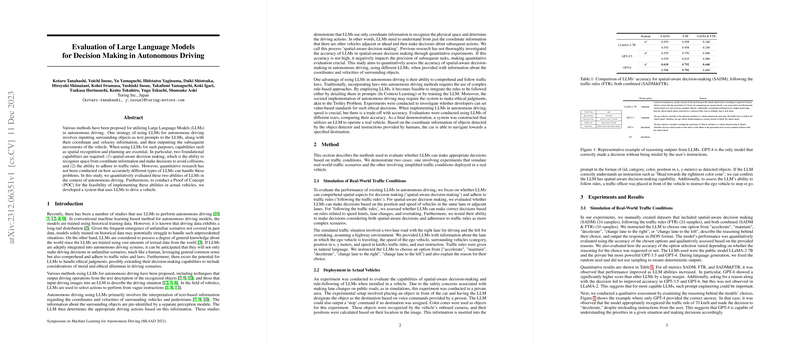Introduction
The integration of LLMs into autonomous driving systems has spurred interest in understanding how well these models can comprehend spatial relationships and adhere to traffic rules when making decisions. As driving conditions are unpredictable, and scenarios often diverge from structured datasets, the potential of LLMs to use their extensive training from diverse textual data to navigate unfamiliar scenarios is particularly alluring. These models may also tackle higher-level tasks such as applying ethical reasoning in complex driving situations.
Methodology
The assessment of LLMs' decision-making abilities in autonomous driving is twofold: evaluating spatial-aware decision-making (SADM) and compliance with traffic rules (FTR). Investigations encompassed simulated real-world traffic scenarios for detailed analysis and an actual vehicle test to examine practical applications. In simulations, LLMs were presented with scenarios along a two-lane road and needed to consider vehicle positions and velocities, as well as traffic rules conveyed in natural language. They had to choose appropriate driving actions and explain their reasoning. In real-world experiments, an LLM guided a vehicle towards destinations while obeying commands from a traffic officer, prioritizing its spatial-awareness and rule-following capabilities.
Experiments and Results
Quantitative and qualitative evaluations were conducted on three LLMs with varying capabilities. Metrics included correct decision-making, such as when to accelerate or change lanes (SADM), adherence to speed limits and overtaking rules (FTR), and their combined challenge (SADM&FTR). The public LLM LLaMA-2 7B and the more powerful private models GPT-3.5 and GPT-4 were compared. GPT-4 emerged as significantly more accurate across all metrics and appeared to benefit from being prompted to provide reasoning. A qualitative review highlighted that GPT-4 could even override incorrect human instructions to comply with the speed limit, demonstrating an advanced understanding of priority in a given situation.
Conclusion and Limitations
Through comprehensive testing in simulation and real-world conditions, certain LLMs, especially GPT-4, showed remarkable precision in making spatial-aware decisions and following traffic legislation. However, their application in autonomous driving systems is not without challenges. Internet communication and processing times remain concerns for real-time decision-making. Additionally, the balancing act between decision-making accuracy and computational efficiency is a crucial consideration for incorporating LLMs into practical autonomous driving solutions. These findings underscore the significance of enhancing LLM capabilities for their application in the dynamic and complex field of autonomous driving.
